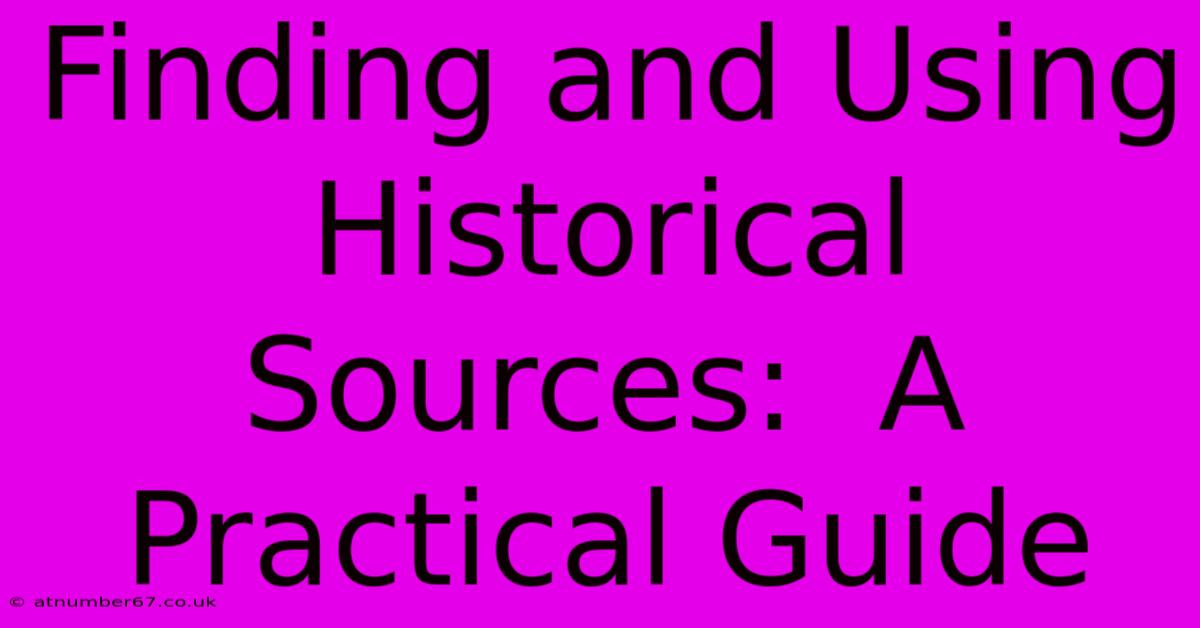Finding And Using Historical Sources: A Practical Guide

Table of Contents
Finding and Using Historical Sources: A Practical Guide
Unlocking the past requires more than just a thirst for history; it demands a strategic approach to finding and utilizing historical sources. This practical guide will equip you with the essential skills and knowledge to navigate the world of primary and secondary sources, ensuring your research is both rigorous and rewarding.
Understanding the Source Landscape: Primary vs. Secondary
Before diving into the search, it's crucial to differentiate between primary and secondary sources. This distinction forms the bedrock of historical research.
Primary Sources: These are firsthand accounts or materials created during the historical period being studied. They offer a direct connection to the past, providing unique insights and perspectives often unavailable elsewhere. Examples include:
- Documents: Letters, diaries, government records, legal documents, maps, and photographs.
- Artifacts: Tools, clothing, furniture, and other tangible objects from the past.
- Oral Histories: Recorded interviews with individuals who lived through a particular historical event.
Secondary Sources: These interpret and analyze primary sources. Historians, journalists, and other scholars create them to provide context, analysis, and different interpretations of past events. Examples include:
- Books: History textbooks, biographies, and scholarly monographs.
- Articles: Journal articles, magazine articles, and newspaper articles.
- Documentaries: Films and television programs that explore historical topics.
Locating Historical Sources: A Multi-pronged Approach
Finding relevant sources requires a multifaceted approach, combining online research with visits to physical archives and libraries.
Online Resources: The digital age has revolutionized historical research. Numerous online databases and archives offer access to a wealth of materials. Consider exploring:
- Digital Archives: Many libraries and institutions have digitized their collections, making them readily accessible online. Look for digital collections focusing on your specific area of interest.
- Online Databases: Subscription-based databases, such as JSTOR and Project MUSE, provide access to scholarly articles and journals. Your local library likely offers subscriptions.
- Government Websites: Government websites at the national, state, and local levels often house valuable historical documents and records.
- Crowdsourced Archives: Platforms like Ancestry.com and FamilySearch offer vast genealogical resources, including census records and vital records. (Note: These often require subscriptions.)
Physical Archives and Libraries: While online resources are invaluable, physical archives and libraries remain crucial for accessing unique and rare materials.
- University Archives: University archives often hold extensive collections relating to their institution's history and the broader community.
- National Archives: National archives preserve government records and documents, providing a rich source for research.
- Local Historical Societies: Local historical societies frequently collect and preserve materials related to a specific geographic area.
- Museums: Museums house artifacts and documents related to various aspects of history.
Evaluating Sources: Critical Analysis is Key
Once you've located potential sources, critical evaluation is paramount. Don't accept information at face value; analyze the source's:
- Author: Who created the source? What is their background and potential biases?
- Context: When and where was the source created? What were the circumstances surrounding its creation?
- Audience: Who was the intended audience for the source? How might this influence the information presented?
- Purpose: What was the author's purpose in creating the source? Was it to inform, persuade, or entertain?
- Reliability: Does the source align with other known historical information? Are there any inconsistencies or contradictions?
Using Historical Sources Effectively: Synthesis and Interpretation
The final step involves synthesizing and interpreting your findings. This process involves:
- Comparing and Contrasting: Comparing different sources helps you identify common themes, conflicting perspectives, and potential biases.
- Contextualizing: Placing your sources within their broader historical context is vital for accurate interpretation.
- Developing an Argument: Use your sources to support a well-defined argument or thesis statement.
- Proper Citation: Always cite your sources properly to avoid plagiarism and give credit to the original creators.
By mastering these steps, you can effectively navigate the world of historical sources, turning your research into a compelling and insightful exploration of the past. Remember, rigorous research and critical analysis are paramount to uncovering the truth behind historical narratives.

Thank you for visiting our website wich cover about Finding And Using Historical Sources: A Practical Guide. We hope the information provided has been useful to you. Feel free to contact us if you have any questions or need further assistance. See you next time and dont miss to bookmark.
Featured Posts
-
Janhvi Kapoor Her Mothers Greatest Gift
Apr 06, 2025
-
Dragon Age Veilguard Character Creation Step By Step
Apr 06, 2025
-
J K Rowlings Wealth Inspiration Or Controversy
Apr 06, 2025
-
The Extraordinary Life Of Travis Barker Net Worth And Beyond
Apr 06, 2025
-
Pj Pattersons Age More Than Just Numbers
Apr 06, 2025
